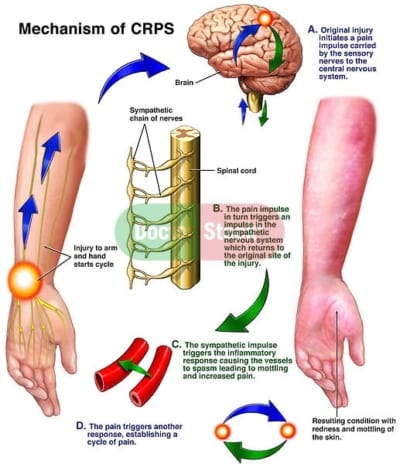Brooklyn, NY 11212
24/7 Customer Support
Complex regional pain syndrome (CRPS), also called reflex sympathetic dystrophy syndrome, is a chronic pain condition in which high nerve impulses are sent to an affected site. Experts believe that CRPS occurs as a result of dysfunction in the central or peripheral nervous systems.
CRPS is most common in people aged 20-35. The syndrome also can occur in children; it affects women more often than men.
There is no cure for CRPS.
CRPS most likely does not have a single cause but results from multiple causes that produce similar symptoms. Some theories suggest that pain receptors in the body’s affected part become responsive to catecholamines, a nervous system messengers group. In injury-related CRPS, the syndrome may be caused by a triggering of the immune response, which may lead to the inflammatory symptoms of redness, warmth, and swelling in the affected area. For this reason, it is believed that CRPS may represent a disruption of the healing process.

The symptoms of CRPS vary in their severity and length. One sign of CRPS is continuous, intense pain that gets worse rather than better over time. If CRPS occurs after an injury, it may seem out of proportion to the injury’s severity. Even in cases involving an injury only to a finger or toe, pain can spread to include the entire arm or leg. In some cases, pain can even travel to the opposite extremity. Other symptoms of CRPS include:
• “Burning” pain
• Swelling and stiffness in affected joints
• Motor disability, with decreased ability to move the affected body part
• Changes in nail and hair growth patterns. There may be rapid hair growth or no hair growth.
• Skin changes. CRPS involves skin temperature changes — skin on one extremity can feel warmer or cooler compared to the opposite extremity. Skin color changes also are apparent as the skin is often blotchy, pale, purple, or red. The texture of skin also can change, becoming shiny and thin. People with syndrome may have skin that sometimes is excessively sweaty.
• CRPS may be heightened by emotional stress.
There is no specific diagnostic test for CRPS, but some testing can rule out other conditions. Triple-phase bone scans can be used to identify changes in the bone and blood circulation. Some health care providers may apply a stimulus (for example, heat, touch, cold) to determine whether there is a pain in a specific area.
Making a firm diagnosis of CRPS may be difficult early in the disorder when symptoms are few or mild. CRPS is diagnosed primarily through observation of the following symptoms:
• The presence of an initial injury
• A higher-than-expected amount of pain from an injury
• A change in the appearance of an affected area
• The presence of no other cause of pain or altered appearance
Since there is no cure for CRPS, treatment aims to relieve painful symptoms associated with the disorder. Therapies used include psychotherapy, physical therapy, and drug treatment, such as topical analgesics, narcotics, corticosteroids, antidepressants, and anti-seizure drugs.
Other treatments include:
• Sympathetic nerve blocks: These blocks, which are done in various ways, can provide significant pain relief for some people. One kind of block involves placing an anesthetic next to the spine to block the sympathetic nerves directly.
• Surgical sympathectomy: This controversial technique destroys the nerves involved in CRPS. Some experts believe it has a favorable outcome, while others feel it makes CRPS worse. The technique should be considered only for people whose pain is dramatically but temporarily relieved by selective sympathetic blocks.
• Intrathecal drug pumps: Pumps and implanted catheters are used to send the pain-relieving medication into the spinal fluid.
• Spinal cord stimulation: This technique, in which electrodes are placed next to the spinal cord, offers relief for many people with the condition.
By reading this website, you acknowledge that you are responsible for your own health decisions. The information throughout this medical website is not intended to be taken as medical advice. The information provided is intended for general information regarding Pain Management symptoms and services.
If you are interested in finding out more, avoid worrisome self-diagnosis, please contact our Pain Management specialist for a personal consultation. No information on this site should be used to diagnose, treat, prevent, or cure any disease or condition.